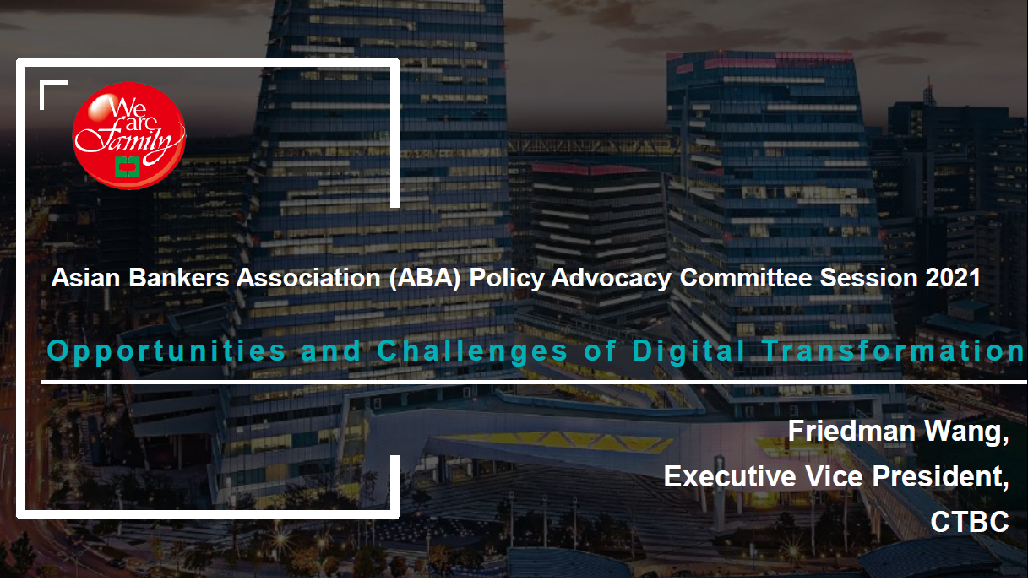Opportunities and challenges of digital transformation
I. Background
 According to the Dell Technologies Digital Transformation Index (DT Index) survey, due to COVID-19, all industries in the world turn proactive in digital transformation, and up to 80% of companies have accelerated their digitalization plans in 2020. In the digital age, customers are paying more attention to the differentiation of products and services, as well as personal experience.
According to the Dell Technologies Digital Transformation Index (DT Index) survey, due to COVID-19, all industries in the world turn proactive in digital transformation, and up to 80% of companies have accelerated their digitalization plans in 2020. In the digital age, customers are paying more attention to the differentiation of products and services, as well as personal experience.
Under the influence of these factors, digital transformation is no longer a choice for the bank to operate better, but the key to survive.
II. Challenges of digital transformation in banking
Financial services have been reinvented by technology in five new ways which are real-time, anywhere and anytime, seamlessly integrated with life scenes of customers, personalized, and predictive. Although technology can help the financial industry provide new services, from product-oriented services to customer-centric, traditional banks still face four major challenges of organization, customers, and competitors in the process of digitization.
In the following paragraph, we will divide the challenges into three internal challenges and two external challenges for discussion.
III. Internal challenges
(1) Strategy of the company
As resources and budgets are limited, should we choose to change the bank or run the bank? In traditional banking services, the returns grow linearly with the investments over time. During the FinTech age, the profit will not be seen at the initial stage, but the investment gains will grow exponentially as time goes by. In addition, the winner takes most of the market shares eventually. Therefore, the short-term business goals that management wants to achieve may conflict with the long-term transformation goal of the organization.
Many transformation plans are led by the supervisor responsible for a single project at the current stage. Nonetheless, it might take 5 to 10 years to achieve the breakthrough of the transformation. Therefore, it is difficult to reflect the performance of the leader in a short period. Financial institutions should reevaluate key performance indicators (KPI) to incentivize digital transformation.
(2) Organizational baggage
(2.1) The silo effect
Traditional banking organizations are hierarchical and MBO-driven, each department works like an independent company, responsible for its own P&L instead of the company’s long-term mission. Due to lack of the mechanisms for horizontal communication, it’s hard to integrate resources from different parties for jointly developing a single product and moving the project forward.
(2.2) Complicated system infrastructure
Confronted with customers’ expectation of personalized and real-time services and better user experience, banks have to respond quickly to customers’ requirements in the digital age. To keep up with the trend, banks have to get rid of outdated information system architecture which is hard to quickly iterate, and redesign system architecture based on micro-service architecture to respond to rapidly changing business demands.
(3) Talents
The ever-evolving manpower requirements have forced many financial institutions to rethink how to retain outstanding talents. The types of talents required by financial institutions are different nowadays. Upon digital transformation, banks need not only financial background talents, but interdisciplinary talents with backgrounds in data science, technology, UIUX. However, FinTech startups are also competing for the same talents, so the challenge that the financial industry facing is not only talents recruitment, but also talents retention.
In our company, traditional suit-dressed bankers need work with data or AI science wearing jeans and t-shirt in the same working area. The cultures will be a key factor for the success of digital transformation.
IV. External challenges
(1) Emerging FinTech startups
Traditional banks tend to focus on the entire customer base, while FinTech startups pay attention to doing one service well. Take TransferWise, Europe’s most valuable Fintech company now, as an example, concentrating on an international remittance service that solves the pain point of handling fees of cross-border remittance. If thousands of rising FinTech companies do perfectly in one service, comparing to banks want to do each service just ok instead of do perfectly. Who will win this game?
As reported by McKinsey’s “Winning in a world of ecosystems” report released in 2019, the financial industry must embrace ecosystem strategy if it wants to enhance its competitiveness and profitability, and fight against emerging rivals such as technology companies and internet-only banks.
(2) Customers that are highly digitalized due to emerging technologies
Nowadays, customers are more demanding since they enjoy the digital service of each industry, such as online store. Therefore, customer behavior and demand is more difficult to predict. Consequently, the core of digital transformation is customer, focusing on customer’s needs, experience and journey. Banks need to change from product-centric to situation-centric, focus on the purpose of customer’s use of financial services, not just focus on the product itself. Situation-centric perspective will alter the way that banks design financial products and services, find out potential business partners, and expand the ecosystem of the bank. This is also what Brett King emphasized, banking everywhere, banking services will be integrated into customers’ lives invisibly.
V. Opportunities of digital transformation in CTBC
(1) Due to the impact of COVID-19, digital financial services have highly accepted
Based on the Institute for Information Industry’s survey on mobile payment usage in the first half of 2020, if merchants support all payment methods, 35.3% of Taiwanese customers use mobile payment. For the first time, its usage has surpassed physical credit/debit cards (33.9%).
This trend has also been verified through CTBC’s customers. According to CTBC’s digital financial survey, as many as 70% of our customers use financial services at least once a week, among these services, mobile payment is the most popular one.
(2) Customer-centric digital culture and agile mindset promote bailout loan approval
During COVID-19, 26% of the national bailout loan was undertaken by CTBC, the number of applications that we handled in a month used to take two years long to process. The followings are the three key factors that make this magic happen:
- Fully digitalized application process
- Intelligent credit analysis engine
- Robotic Process Automation
(3) Embracing ecosystem strategy to access to customers that can’t be served
In the report of statistics, there are still more than 8 million of Taiwanese adults without a credit card. These cardless users were inaccessible to banks in the past. In the age of the financial ecosystem, every bank tries to cooperate with e-commerce companies, communication software companies, supermarkets, etc., and looks forward to integrating online and offline services into a one-stop service, in order to acquire these cardless users.
CTBC collaborates with LINE to create the first “Community Payment Ecosystem”, allowing customers to complete card application, mobile payment binding, point accumulation and redemption within a single mobile APP. Since the initiating of this service, it has created 10 billion points of circulation value.
(4) Lower the investment threshold and realize inclusive financing
In the past, the investment threshold was high which was not conducive to the general public. However, the digital provides lower cost to serve customers, including investment service, therefore, the entrance of investment has dropped from 100 USD to just 1 USD.
(5) Catch customer preferences and create hyper-personalization.
- CTBC has more than 9 million customers and the number of mobile banking users has exceeded 3.6 million, the largest number of mobile banking users in Taiwan.
- Among the 9 million customers, 69% of them use multiple channels to interact with CTBC, and 31% of them use a single channel.
- In addition, based on our study, the satisfaction of multi-channel customers is 83% which is 13% higher than the 70% satisfaction of single-channel customers.
- Thereby, we build CTBC Brain Platform, containing three research and development areas, six core applications, and four scenarios. The ultimate goal of CTBC Brain Platform is to use data to immediately catch every stage of customers’ life journey and create hyper-personalized service. From education, entertainment, job hunting, income and expenditure to retirement, we use CTBC Brain Platform to analyze each offer each customer with right product, at right time and right channel.
The presentation file can be downloaded HERE.
The video recording of ABA Policy Advocacy Committee Meeting can be viewed in the ABA YouTube.
Prepared for the Asian Bankers Association by:
 Friedman Wang
Friedman Wang
Executive Vice President
CTBC Bank Co. Ltd.

